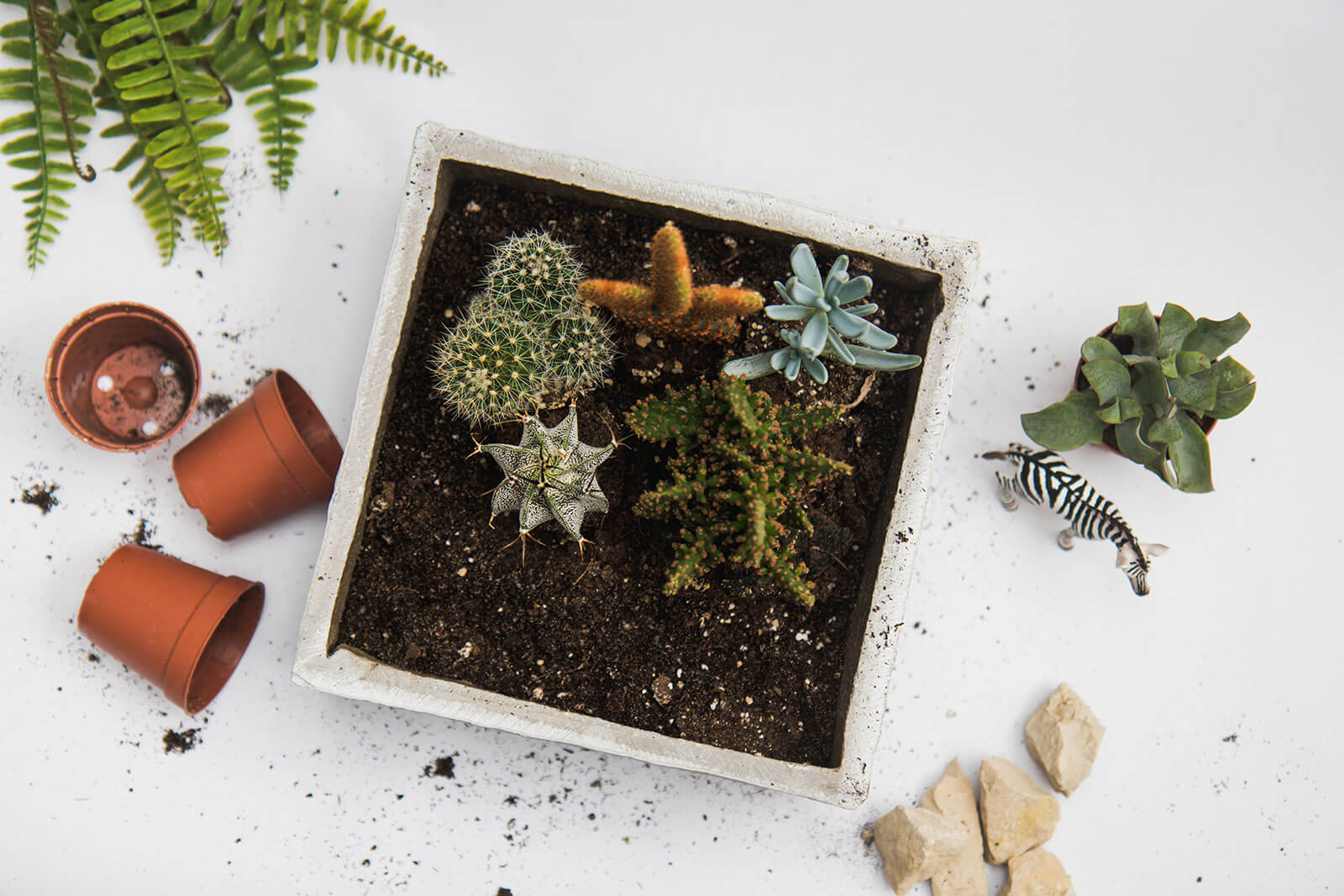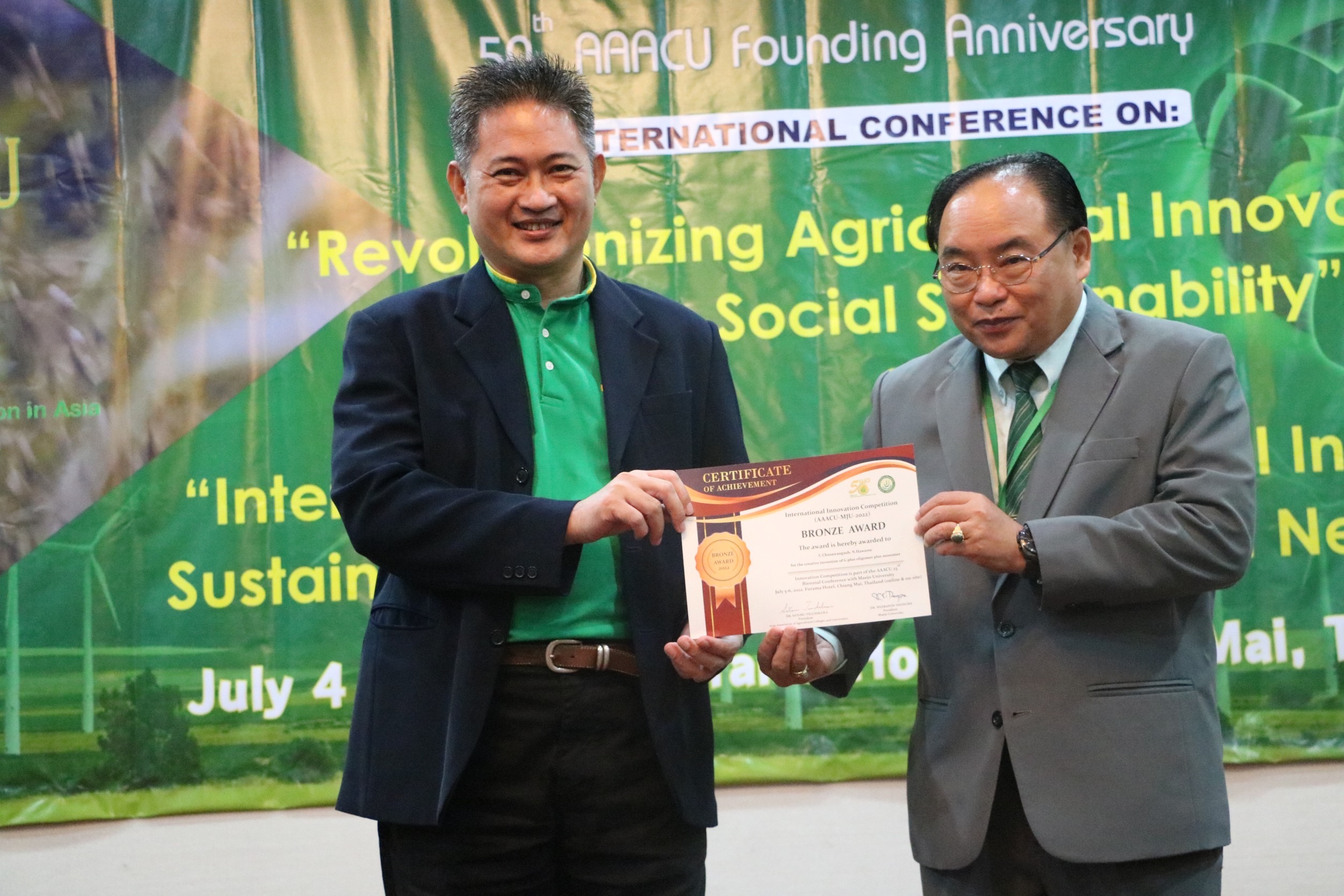The scientific name for durian is Durio zibethinus L., and it belongs to the
Bombacaceae family. It is a tropical fruit that is cultivated extensively in Thailand’s eastern and southern areas. Durian farming is not only produced for local consumption; it is also produced for export overseas, both as fresh fruits and processed in different ways. (Klubnuam and Pudmetej, n.d.)
Durian has been cultivated for commercial locally in southeast Asia for more than a century. Durian care practices in the pre-production period are important for durians to grow rapidly and provide faster productivity. Thailand has a durian planting area of 791,165 rai in 2020, which is distributed across all areas of the nation as follows: the South, East, North, and Northeast. with productive regions of 437,993, 299,184, 47,636, and 6,352 rai respectively. The southern region, particularly Chumphon, Nakhon Si Thammarat, Yala, and Surat Thani, has the most durian-growing regions. and the eastern area, which includes Chanthaburi, Rayong, and Trat. (Office of Agriculture Economics, 2020)
Thailand is the world’s largest exporter of durian accounting for 77.33% of the world’s export value of fresh durian. In 2021, the volume of fresh durian exported was 620,892.72 tons, valued at 2,072.79 million US dollars. (Department of Trade Negotiations, Ministry of Commerce, 2022)
Durian is a fruit tree with numerous diseases and insect pests. Farmers confront disease and insect pest issues that always cause harm from the beginning of development until harvest. The most prevalent durian diseases are root and foot rot, fruit rot, leaf blight, algal leaf spots, pink disease, and powdery mildew. (Chuebundit et al, 2020)
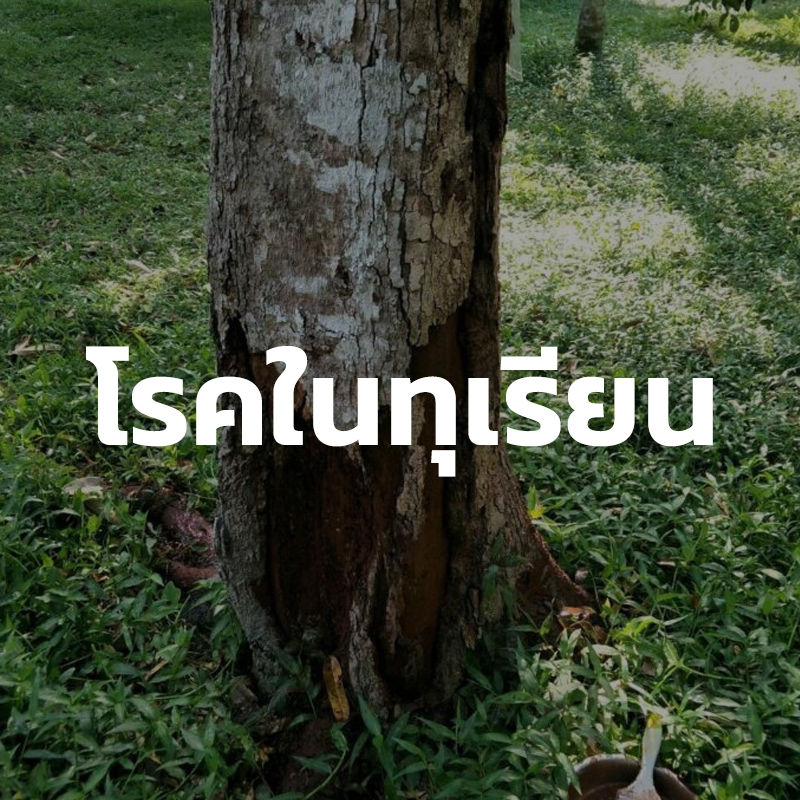
Durian Root and foot rot disease
Root rot is a problem that destroys durian trees in tropical areas. Root rot disease in durian is the most important disease that causes crop loss, and limits production and durian trees can be damaged to death. The root rot disease is caused by several Phytophthora species, including P. palmivora, Fusarium spp., and Lasiodiplodia pseudotheobromae (Suksiri et al., 2018; Chantarasiri and Boontanom, 2021; Kongtragoul et al., 2021).
S. Suksiri et al. (2018) examined pathogens by collecting soil samples from durian trees showing root and stem rot disease in durian orchards in Chumphon province, Southern Thailand. The reports demonstrate that P. palmivora and P. cucurbitacearum were highly pathogenic isolates (Suksiri et al., 2018). A. Chantarasiri & P. Boontanom (2021) evaluated fungal pathogens causing stem rot disease on durian trees by collecting symptomatic bark and wood samples from different durian orchards in Rayong and Chanthaburi Provinces in Eastern Thailand. The report provides evidence that Fusarium solani and Lasiodiplodia pseudotheobromae are the fungal pathogens causing stem rot disease on durian trees (Chantarasiri and Boontanom, 2021).
Root and foot rot is caused by a fungus that develops and destroys durian at the base, stem, branches, and roots. It is common to see rough, non-glossy foliage on diseased trees, and the color gradually fades to yellow before falling off (Figure 2.1). Rot and wilting of the foliage are symptoms of diseased plants. Wounds on stems or branches will rot and turn into succulent spots. The bark rots turn brown and produce mucus (Figure 2.2), which is noticeable in the morning or during humid weather. When the bark is pulled away, the inner bark is reddish brown or dark brown, and when the roots are dug up, the taproot and fibrous roots are injured and brown rot (Figure 2.3), causing the durian tree to deteriorate and eventually perish. (Klubnuam and Pudmetej, n.d.; Department of Agriculture [DOA], 2022)
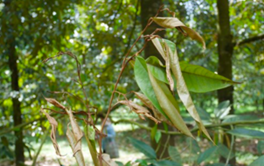
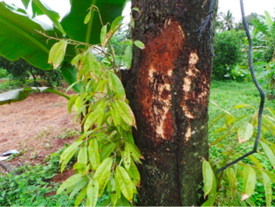
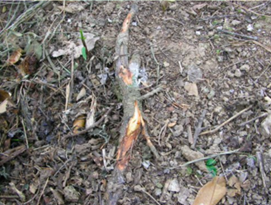
The researcher used a digital microscope to study the phloem tissues of durian bark and discovered different features related to the severity of root and foot rot diseases. The healthy tissue is yellow. The tissues change slightly brown, dark brown, and reddish brown depending on the severity of the disease. (Figure 2.4)

healthy (A), mild infection (B), moderate infection(C), and severe infection (D)
Phytophthora fungus can survive on the soil for many years as chlamydospores. It can germinate into hyphae and develop sporangium when the environment is appropriate, which is the origin of zoospores that have tails moving through the water to destroy plant roots. Furthermore, the disease is transmitted by windstorms and floods and infected breeding stems and growing soil.
Durian disease control
The following techniques are used in combination to prevent and eradicate root rot disease, as suggested by the DOA:
- The crop area should have good drainage and should not overflow.
- Improve the soil by adding manure or compost and adjusting the soil acid-base condition or pH to around 6.5.
- Avoid damaging the roots or stems. This will provide an easy route for the fungi that cause the disease to destroy the plant.
- The durian tree that is severely infected or the entire tree that is desiccated and deceased should be pulled and cut down outside of the planting field. The soil should then be allowed to dry before planting a new tree to replace it.
- Inspect the field on a regular basis, and if diseased sections, leaves, blossoms, or fruit are discovered, cut them, and eliminate them outside the planting field prior to spraying fungicide.
- Pruning tools used on infected plants should not be used on healthy plants, and tools should be cleaned before each use.
- After harvesting, prune the diseased dry branches and cut off the leftover fruit stalks outside the planting area to minimize pathogen accumulation.
- Control the number of pathogens in the soil by using the fungus antagonist Trichoderma.
Farmers have applied various fungicide groups such as phenylamide, the quinone outside inhibitors, and carboxylic acid amides to control these pathogens. Metalaxyl of the phenylamide group is the most commonly applied as a fungicide. It is applied daily in the durian plantations of southern Thailand, typically 2-3 times per month or more frequently during the rainy season from May to October, causing the development of resistance to this fungicide. The discovery of P. palmivora isolates resistant to metalaxyl suggested that this fungicide may be ineffective in suppressing Phytophthora infections in durians. Metalaxyl was sprayed, but its effectiveness was poor, resulting in reduced or total loss of durian harvests. Fungicide-resistant Phytophthora strains have been reported in many countries including Thailand. This becomes increasingly a more important issue in managing root rot disease in durian efficiently and safely. Additionally, the side effects of fungicides may come with risks, such as serious hazards to farmers, consumers, and the environment. (Kongtragoul et al., 2021)
Plant diseases, which are brought on by a variety of microorganisms, including fungi, bacteria, viruses, nematodes, and protozoa, have a significant negative impact on agricultural productivity and yield. Plant disease incidence has been decreased by the use of pesticides, less susceptible cultivars, crop rotation, and other management strategies, but their efficacy is often insufficient since soil-borne infections frequently persist and evolve resistance. In addition, employing synthetic pesticides excessively affects the environment and living organisms disrupts ecosystems, and lowers agriculture’s sustainability. (Miljakovic et al., 2020) Misusing chemical pesticides leads to soil and groundwater pollution and a rise in diseases and pesticide resistance. In addition, pesticides have negative effects on creatures that are not intended to be affected by them, such as beneficial insects like pollinators, soil microbiomes, and the health of terrestrial and aquatic ecosystems in general. (Tyskewickz et al., 2020)
Integrated Pest Management (IPM), organic farming, and other sustainable food production methods are used to protect the environment from the harmful effects of chemical fungicides. Biological Control Agents (BCAs), which are based on active microorganisms or their metabolites and natural products that reduce the population of plant pathogens, are one of these strategies. (Tyskewickz et al., 2020) BCAs have been developed in the past decades for the management of fungal and bacterial diseases. Some of the most intensively studied are bacterial and fungal belonging to the genus Pseudomonas spp., Bacillus spp., Streptomyces spp., Trichoderma spp., Glomus mosseae, Gliocladium virens, Pythium oligandrum, and Beauveria bassiana. They have been utilized as BCAs to successfully control the soil-borne diseases of valued crops caused by fungi, oomycetes, bacteria, and nematodes. To protect plants against pathogen infections, bacterial biocontrol agents employ a wide range of strategies. They may interact directly or indirectly with the pathogen to prevent or minimize plant disease via one or a combination of methods. (Tyskewickz et al., 2020: Bonaterra et al., 2022)
